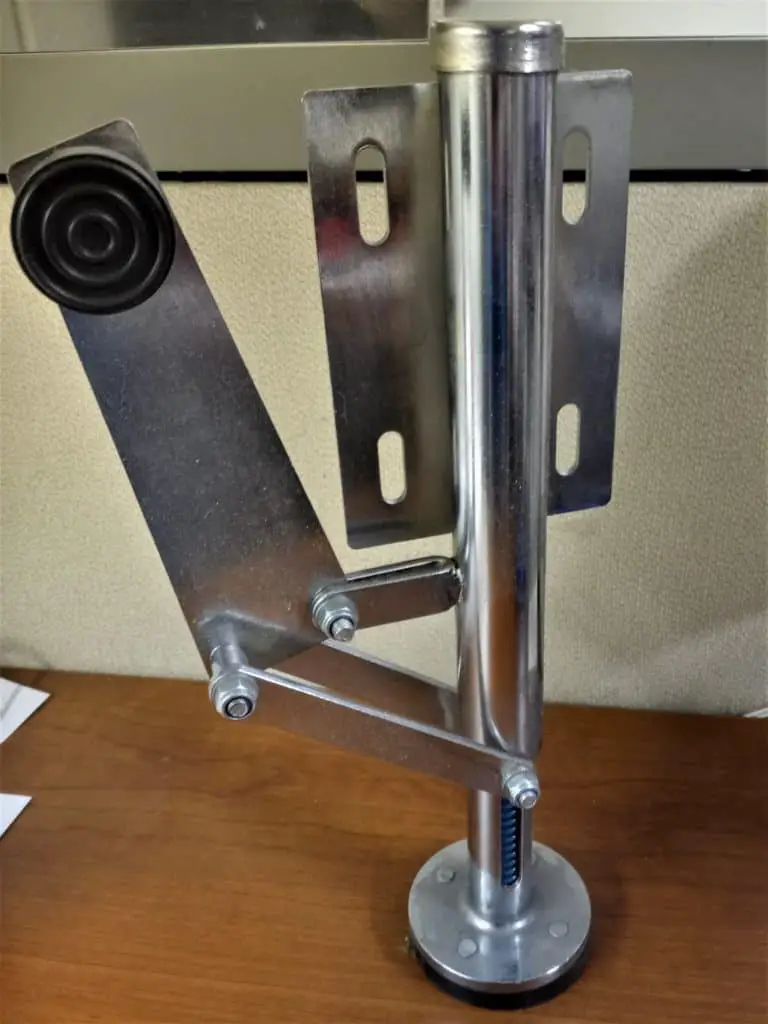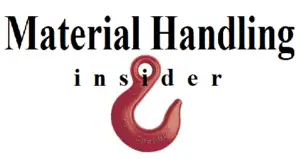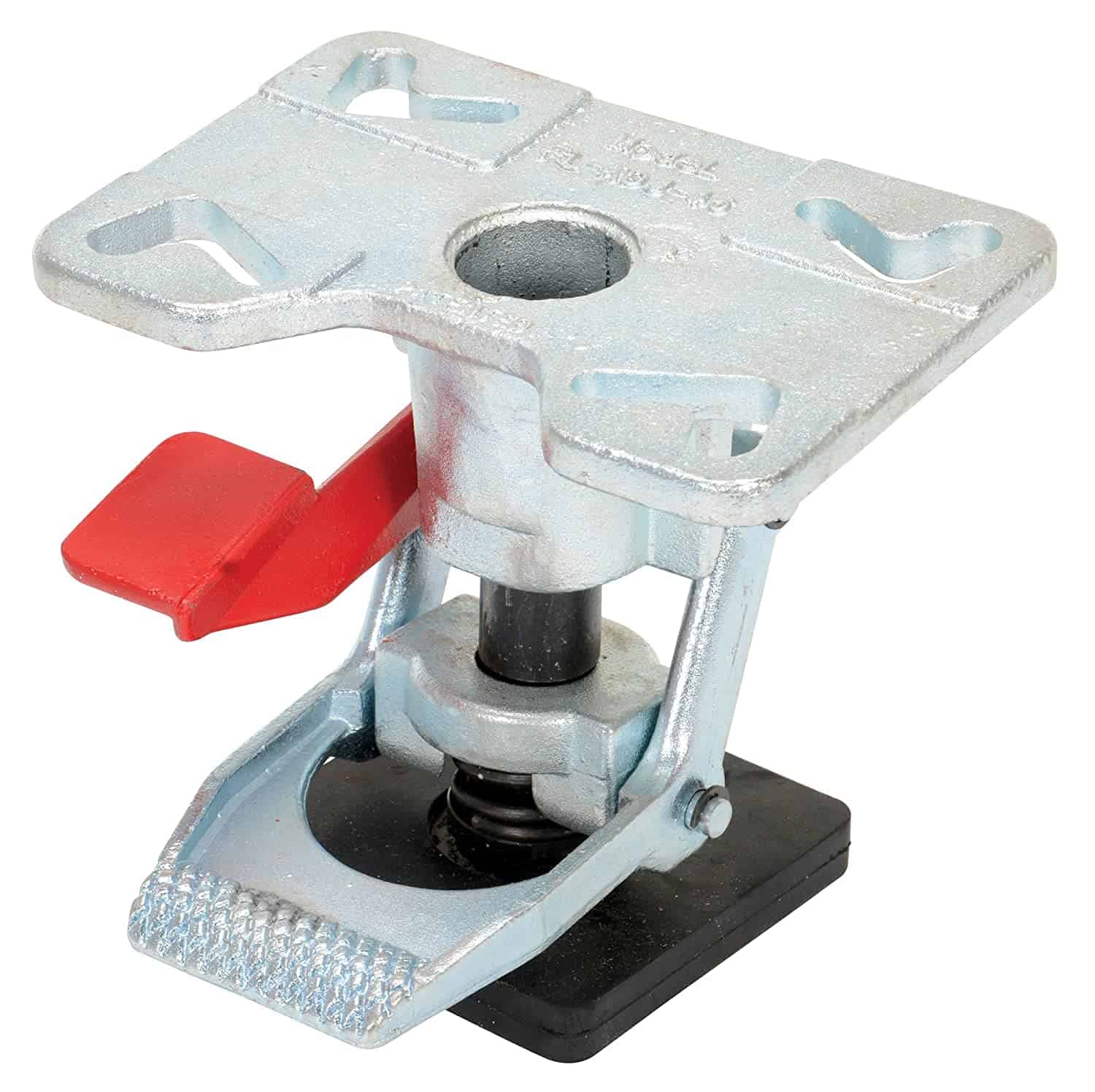If you are new to the material handling industry, you might not have never heard the terms “floor lock”, “floor lock brake” or “floor truck lock”. You may also be unaware of what one looks like, or what they are used for. You just may find yourself asking “What is a floor lock?”, “What does a floor lock do?” and “How does a floor lock work?”
In my 30 plus years of designing material handling equipment, I have utilized floor locks to immobilize carts and platform trucks when not in use. There are different types of floor locks, each having their own advantages and dis-advantages.
What is a floor lock and what do they do?
A floor lock is a mechanical device used to hold a cart, platform truck, trolley or other wheeled equipment in place when engaged. Floor locks work by transferring some of the carts weight to a friction pad that contacts the floor. When disengaged, the friction pad is retracted away from the floor allowing the cart to roll freely.
How does a floor lock work?
The mounting plate attaches the floor lock to the cart. The extension mechanism extends the friction pad. The friction pad transfers some of the cart’s weight to the ground and creates friction between the lock and the floor. They all three work in unison to make an effective floor lock.
Floor locks are NOT intended to function as a jack, or a lift. They are commonly thought of as having that capability, but they are not designed to lift the cart’s wheels off the ground. That can be done by a lifting jack, leveling jack or a trailer jack.
Since the floor lock is mounted separately from the casters, the floor lock can be located in such a way as to give the operator better access to the locking pedal.
What makes up a floor lock?
Floor lock assemblies are made up of 3 main components. The mounting plate, the extending mechanism, and the friction pad. Each component serves a specific purpose.
Component 1 “The mounting plate”
The mounting plate is the part of the floor lock that contacts the cart, platform truck, trolley or dolly. It is important that the mounting plate be securely attached to the cart. The three most common ways for a floor lock to be mounted are by bolting, pinning or welding.
Bolting – The majority of the time the floor lock is bolted on using fasteners. For most applications, this is the preferred method. It allows the lock to be securely mounted, and easily removed requiring only rudimentary tools. To ensure that the lock is properly secured, fasteners with a locking element are often used. It is important to follow the manufacturer’s instructions and tighten the fasteners to the proper torque.
The bolt hole pattern is made up of 3 important pieces of information. The bolt hole size. The horizontal spacing. And the vertical spacing. Some plates are fitted with slots to accommodate multiple bolt hole spacings.
Welding – Welding ensures a secure connection but interrupts the protective coating of the lock in the area that is welded. Welding also presents a problem when it comes to replacing a worn or damaged lock. Welding is also not a viable solution in certain situations where the base metal of the lock is not compatible with the base metal of the frame of the cart.
Pinning – Pinning is often done with a quick disconnect mounting plate, or similar mechanism. Pinning is usually accomplished by entrapping some of the floor locks edges, then using another mechanism to hold the remaining edges. Pinning is great for applications that require frequent replacement of floor lock. Pinning tends to have some play in the connection that could be the source rattling noise while the truck is being pushed.
Component 2 “Force generating extending mechanism”
Floor locks all have a mechanism that generates force that extends the friction pad to the floor in order to create friction. They also have a mechanism that positively locks it in the extended position until the user releases it. Once the user releases the lock, a spring or something of that nature retracts the friction pad back to its original position.
The force that operates the lock is generally applied through a foot pedal. There are a few locks that are designed to be applied through use of a hand lever. The force applied to the pedal or hand lever is generally not sufficient to hold the cart in place. A well-designed floor lock will use a form of mechanical advantage to multiply the operators force into a much higher amount. This can be done with the mechanical advantage achieved from simple levers and toggle joints. Toggle joints are by far the best way to design a lock because the force generated can be extremely high. Toggle joints can be made compact. Toggle joints have an over center characteristic that locks it in the extended position until it is released by the user.
Component 3 “Friction pad”
The friction pads are what creates friction between the floor and the lock. They are what gives the floor lock its holding power. The come in many different size and shapes. There are three characteristics that determine the amount of holding power.
Force – Simply stated this is the force generated from the force generating mechanism above.
Area – The surface area that comes in contact with the ground. The contact surface area can be affected by many characteristics of the lock.
First is overall size of the pad, the square inches or millimeter of the face of the pad. Usually bigger is better, but that is not always the case. If the ground is on a slope, or the lock is mounted crooked only a portion of the friction pad may be making contact. One solution is to have a pad that has some articulation to make sure you get the maximum amount of contact as possible. Another solution is to have a softer material on the face of the pad that conforms to the profile of the floor.
Coefficient of friction – This is simply stating how sticky is the material that is making contact with the floor. Simply stated a material like rubber is commonly used, because it offers a high coefficient of friction and conforms to the shape of the floor.
Other Friction pad design elements – One design element usually applied to the friction pad of a floor lock is making it spring loaded. The spring-loaded aspect helps account for variations in the height of the floor, ensuring contact between the lock’s friction pad and the floor.
Another design element often incorporated into a floor lock’s friction pad is adjustability. Having the pad on a threaded rod that can be raised or lowered lets you fine tune just how much force gets transferred to the ground.
Floor Lock Costs, return on investment.
The purchase price of a floor lock can vary significantly. The commodity stamped steel versions can start in the $30 to $50 dollar range. Heavy duty, stainless steel or specialty locks can have a price point of a few hundred dollars.
The main benefit of using a floor lock is the increased safety of the cart not rolling away when the cart is un-attended. A roll away cart may cause damage to the cart, the surrounding structures, the carts payload or bystanders. A simple floor lock has the potential to prevent some types of workplace accidents.
Return on investment (ROI). This is a hard one to figure out, unless you are looking back after an accident. Once you have a dollar amount of exactly how much an accident is costing your company, it will become obvious just how much they could have saved by installing quality, dependable and effective floor locks. One accident costing of tens of thousands of dollars, could pay for a lot of floor locks.
The question becomes, how much is the safety of your workers, products and equipment worth to you?
Picking out a floor lock – specifications
When picking out a floor lock, there are specifications that you need to understand in order to choose the lock that best fits your application.
Effective height / extended overall height – It is the height, or the range that the lock is designed to work at. It will be the dimension from the mounting surface of your lock to the ground.
Retracted overall height – It is the height of the floor lock in the retracted position.
Stroke – Is the distance the friction pad travels when the pedal is depressed. The stroke is generally equal to the ground clearance when the lock is in the retracted state.
Attaching bolt size- Is the size of fastener the mounting plate will accept.
Bolt hole pattern – Is the spacing of the bolt holes. Usually formed into a rectangle, it is simply the width and length dimension between the holes.
Materials– various materials give different performance characteristics. Stamped steel is economical. Cast iron is strong and robust. Cast steel is stronger and more impact resistant. Aluminum is light weight and wont rust. Stainless steel is corrosion resistant.
Self adjusting – Some floor locks claim to be self adjusting. As the pedal is depressed it will adjust to contact the floor. The effective height changes to match the floor.
Types of floor locks
There are many types of floor locks, each having their own pros and cons. Following is a primer on the types of floor locks.
Commodity stamped steel floor locks
The most common type of floor lock is manufactured from stamped steel. The stamped components are welded, plated, and assembled into an economical solution. These locks are usually imported and there is great variation in the design and aesthetics of them. Even though these commodity type floor locks look different, the majority of them function the same.
Below is the FL-6 from Vestil. It has a 6-3/4″ retracted height and a 7-3/4″ extended height. It has an industry standard 4″ x 4-1/2″ top plate size. Bolt hole patterns are 2-5/8″ x 3-5/8″ slotted to a 3″ x 3″.
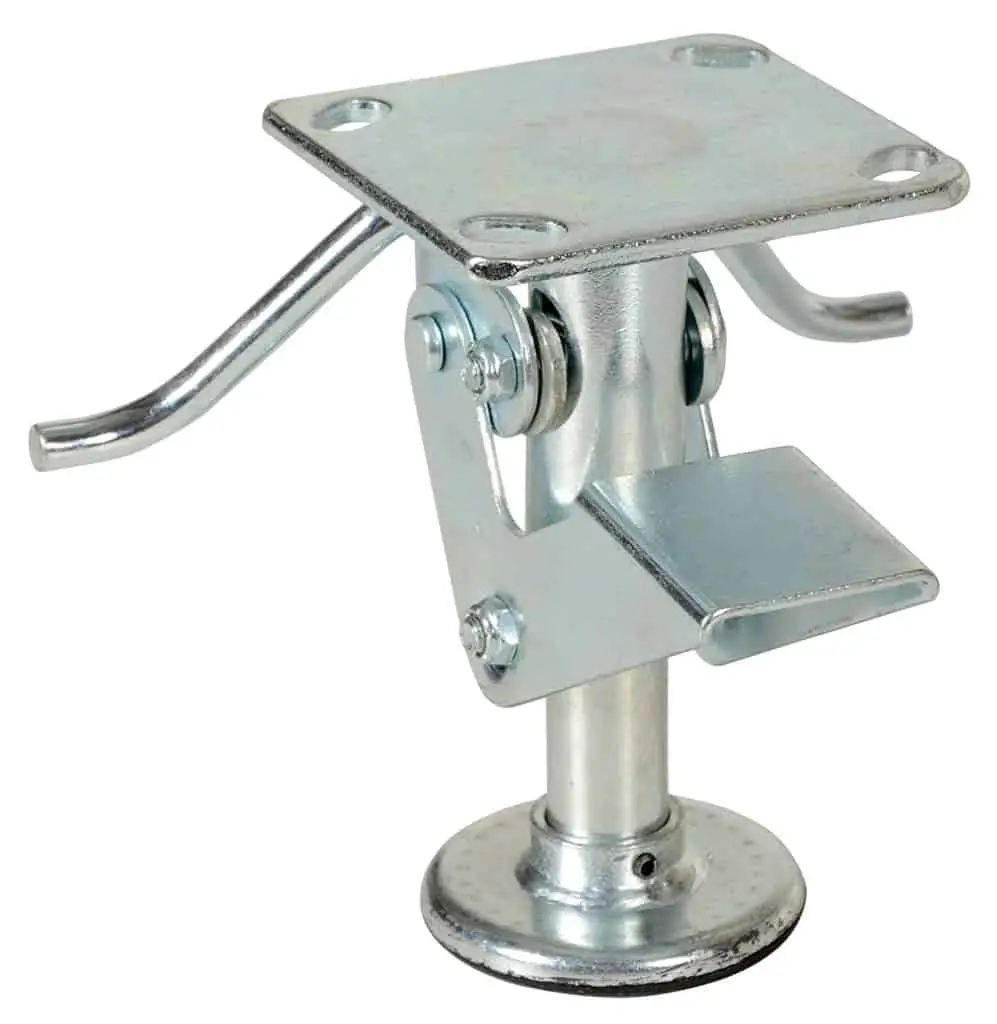
Self-adjusting floor locks
The self-adjusting floor lock from Nutting, has a wider effective range than most other floor locks, and can be mounted in such a way as to have more ground clearance in the retracted position. As opposed to using the mechanical advantage of a toggle joint the Adj-u-lock relies upon the force generated from stepping on the pedal. For this reason, this floor lock will have less holding power than comparable conventional floor locks.
Heavy duty cast steel adjustable floor lock
One of my favorites for heavy duty, abusive applications are the cast steel, adjustable floor locks. The heavy-duty steel bases give these locks a great foundation in which to resist abuse. The pedals and linkage that generate the stopping force are robust. The pad is adjustable to allow it to be fine-tuned in order to generate the most hold power possible. In applications in which corrosion could be a factor, there are stainless steel heavy duty versions. Stainless steel is a good choice for outdoors, high humidity, harsh chemicals and wash-down applications. While they may have a higher initial price point, they may have a lower overall cost in the long run, due to longer life, less maintenance and downtime.
Below is the FL-ADJ-46 from Vestil. Extended height adjustable from 6-1/4″ to 8″. Retracted height adjustable from 5-1/2″ to 7-1/4″. Top plate size 4-1/2″ x 6-1/2″. Attaching bolt size – 3/8″. Shipping weight- 9 lbs
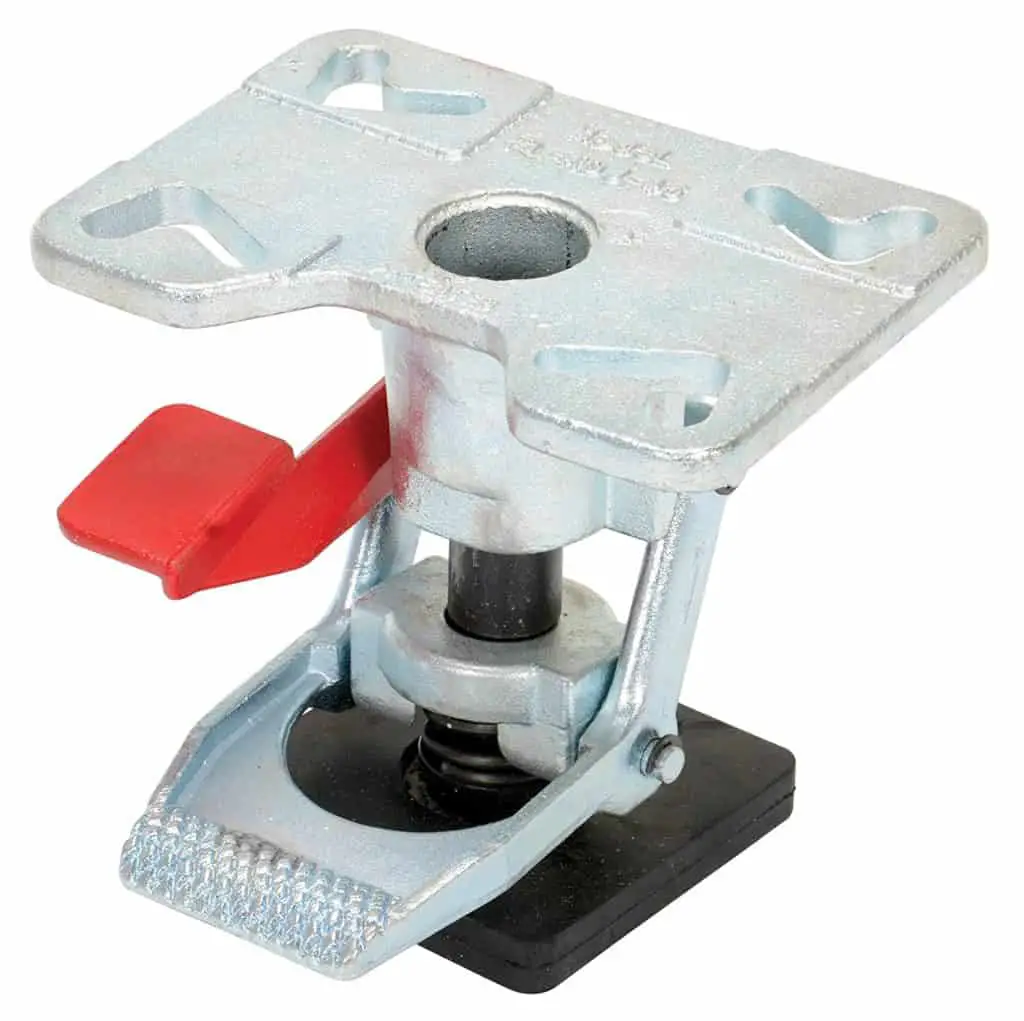
Low profile floor lock
Carts are often designed with low deck heights for various reasons like ergonomics. In those applications there may not be enough ground clearance for a conventional floor lock. One possible solution would be to incorporate a low-profile floor lock. These floor locks take up considerably less space. One potential down-side of the low profile floor lock is that once installed it may be difficult to access.
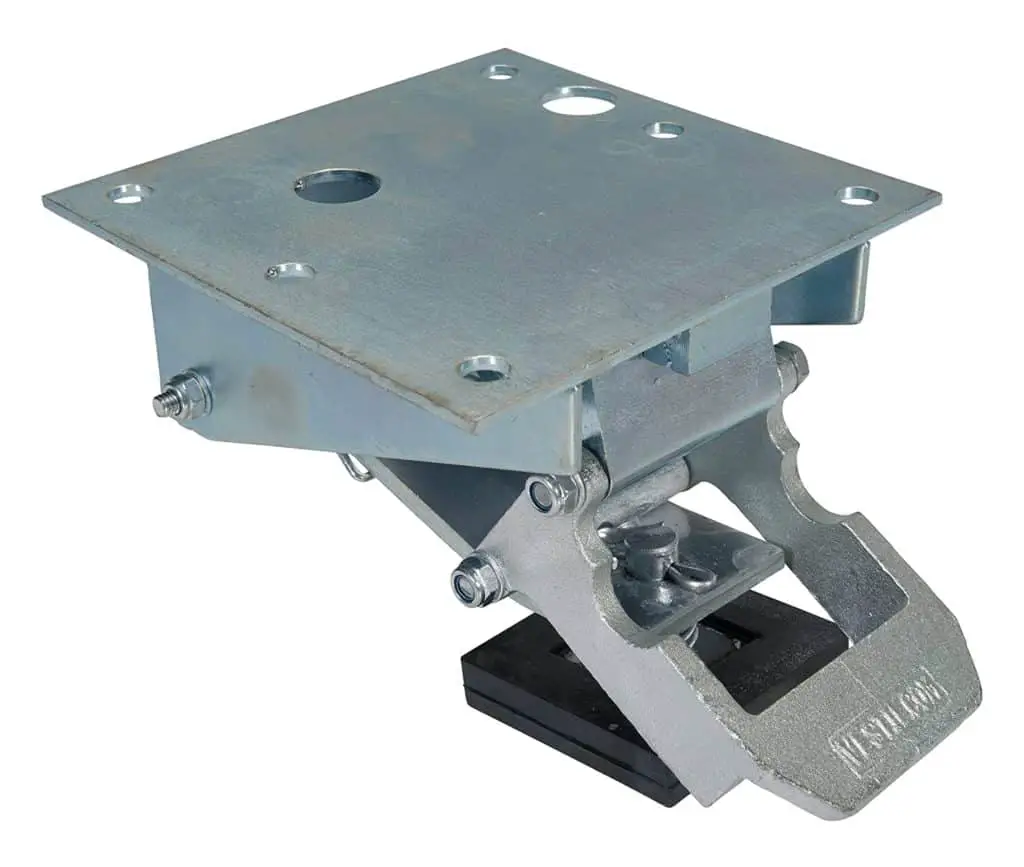
Side mounted floor locks
Sometimes you may not have the height needed for a conventional floor lock. You may also not have enough access to the bottom of the cart. In a tough situation like that…a side mounted floor lock may be a viable solution. It allows you the access that you need and may also allow you to achieve the desired overall height the application calls for.
